Interfacial Reaction and IMC Growth of an Ultrasonically Soldered Cu/SAC305/Cu Structure during Isothermal Aging
Abstract
:1. Introduction
2. Experimental Procedures
3. Results and Discussion
3.1. Microstructure Analysis
3.2. Growth Mechanism of the Total IMC Layer
3.3. Effect of Aging on Shear Strength
4. Conclusions
- (1)
- A single Cu6Sn5 IMC layer was observed at the interfaces after the ultrasonic bonding process, and a Cu3Sn IMC layer was also formed at the interface between the Cu6Sn5 IMC and the Cu substrate because of the reactions between Cu6Sn5 and Cu after isothermal aging. With 800 ms of ultrasonic vibration, some small Cu6Sn5 islands were generated and aggregated into a larger island during subsequent isothermal aging as a result of supersaturated Cu in the solder bulk.
- (2)
- During isothermal aging at 150 °C, the IMC layers of the top and bottom interfaces became thicker. The growth of the IMC was diffusion-controlled and fitted parabolic growth kinetics. For a 400-ms soldering time, the growth rates of the top and bottom interfaces were respectively 3.72 × 10−17 m2/s and 3.90 × 10−17 m2/s. When the bonding time was 800 ms, the growth rates of the top interface and bottom interface were respectively 3.98 × 10−17 m2/s and 4.07 × 10−17 m2/s.
- (3)
- The shear strength of the solder joints with a 400-ms ultrasonic bonding time was lower than that of solder joints with an 800-ms bonding time. The critical reason for this was that the uniform dispersion of small Ag3Sn and Cu6Sn5 particles inside the soft solder could strengthen the solder joints. The shear strength of the solder joints exhibited a slight decline with increasing aging time because of the coarsening of IMC particles and the thickening of the IMC layer. The dimples on the fracture surfaces of the solder joints show evidence of ductile failure behavior with a 400 ms ultrasonic bonding time. After an 800 ms ultrasonic bonding time, the fracture pattern shown a composite fracture containing brittleness and plasticity and tensile shear strength tends to be stable with increasing aging time.
Acknowledgments
Author Contributions
Conflicts of Interest
References
- Abtew, M.; Selvaduray, G. Lead-free solders in microelectronics. Mater. Sci. Eng. R Rep. 2000, 27, 95–141. [Google Scholar] [CrossRef]
- Yim, M.J.; Li, Y.; Moon, K.S.; Paik, K.W.; Wong, C.P. Review of recent advances in electrically conductive adhesive materials and technologies in electronic packaging. J. Adhes. Sci. Technol. 2008, 22, 1593–1630. [Google Scholar] [CrossRef]
- Liu, C.Y.; Hon, M.H.; Wang, M.C.; Chen, Y.R.; Chang, K.M.; Li, W.L. Effects of aging time on the mechanical properties of Sn-9Zn-1.5Ag-xBi lead-free solder alloys. J. Alloys Compd. 2014, 582, 229–235. [Google Scholar] [CrossRef]
- Li, D.; Liu, C.; Conway, P.P. Microstructure and shear strength evolution of Sn-Ag-Cu solder bumps during aging at different temperatures. J. Electron. Mater. 2006, 35, 388–398. [Google Scholar] [CrossRef]
- Shnawah, D.A.A.; Said, S.B.M.; Sabri, M.F.M.; Badruddin, I.A.; Hoe, T.G.; Che, F.X.; Abood, A.N. Microstructure and tensile properties of Sn-1Ag-0.5 Cu solder alloy bearing Al for electronics applications. J. Electron. Mater. 2012, 41, 2073–2082. [Google Scholar] [CrossRef]
- Chen, G.; Peng, H.; Silberschmidt, V.V.; Chan, Y.C.; Liu, C.; Wu, F. Performance of Sn-3.0Ag-0.5Cu composite solder with TiC reinforcement: Physical properties, solderability and microstructural evolution under isothermal ageing. J. Alloys Compd. 2016, 685, 680–689. [Google Scholar] [CrossRef] [Green Version]
- Rizvi, M.J.; Chan, Y.C.; Bailey, C.; Lu, H.; Islam, M.N. Effect of adding 1 wt % Bi into the Sn-2.8 Ag-0.5Cu solder alloy on the intermetallic formations with Cu-substrate during soldering and isothermal aging. J. Alloys Compd. 2006, 407, 208–214. [Google Scholar] [CrossRef]
- Tan, A.T.; Tan, A.W.; Yusof, F. Influence of high-power-low-frequency ultrasonic vibration time on the microstructure and mechanical properties of lead-free solder joints. J. Mater. Process. Technol. 2016, 238, 8–14. [Google Scholar] [CrossRef]
- Huang, H.; Wei, X.; Liao, F.; Zhou, L. Preparation and properties of particle reinforced Sn-Zn-based composite solder. J. Wuhan Univ. Technol. 2009, 24, 206–209. [Google Scholar] [CrossRef]
- Chan, Y.H.; Arafat, M.M.; Haseeb, A. Effects of reflow on the interfacial characteristics between Zn nanoparticles containing Sn-3.8Ag-0.7Cu solder and copper substrate. Solder. Surf. Mt. Tech. 2013, 25, 91–98. [Google Scholar] [CrossRef]
- Gain, A.K.; Chan, Y.C.; Yung, W.K.C. Microstructure thermal analysis and hardness of a Sn-Ag-Cu-1 wt % nano-TiO2 composite solder on flexible ball grid array substrates. Microelectron. Reliab. 2011, 51, 975–984. [Google Scholar] [CrossRef]
- Chellvarajoo, S.; Abdullah, M.Z. Microstructure and mechanical properties of Pb-free Sn-3.0Ag-0.5Cu solder pastes added with NiO nanoparticles after reflow soldering process. Mater. Des. 2016, 90, 499–507. [Google Scholar] [CrossRef]
- Sobhy, M.; El-Refai, A.M.; Mousa, M.M.; Saad, G. Effect of ageing time on the tensile behaviour of Sn-3.5 wt %Ag-0.5 wt %Cu (SAC355) solder alloy with and without adding ZnO nanoparticles. Mater. Sci. Eng. A 2015, 646, 82–89. [Google Scholar] [CrossRef]
- Ko, Y.K.; Kwon, S.H.; Lee, Y.K.; Kim, J.K.; Lee, C.W.; Yoo, S. Fabrication and interfacial reaction of carbon nanotube-embedded Sn-3.5Ag solder balls for ball grid arrays. J. Alloys Compd. 2014, 583, 155–161. [Google Scholar] [CrossRef]
- Li, Z.; Li, M.; Xiao, Y.; Wang, C. Ultrarapid formation of homogeneous Cu6Sn5, and Cu3Sn intermetallic compound joints at room temperature using ultrasonic waves. Ultrason. Sonochem. 2013, 21, 924–929. [Google Scholar] [CrossRef] [PubMed]
- Ji, H.; Qiao, Y.; Li, M. Rapid formation of intermetallic joints through ultrasonic-assisted die bonding with Sn-0.7Cu solder for high temperature packaging application. Scr. Mater. 2016, 110, 19–23. [Google Scholar] [CrossRef]
- Xiao, Y.; Li, M.; Wang, L.; Huang, S.; Du, X.; Liu, Z. Interfacial reaction behavior and mechanical properties of ultrasonically brazed Cu/Zn-Al/Cu joints. Mater. Des. 2015, 73, 42–49. [Google Scholar] [CrossRef]
- Shchukin, D.G.; Skorb, E.; Belova, V.; Möhwald, H. Ultrasonic cavitation at solid surfaces. Adv. Mater. 2011, 23, 1922–1934. [Google Scholar] [CrossRef] [PubMed]
- Ashokkumar, M. The characterization of acoustic cavitation bubbles—An overview. Ultrason. Sonochem. 2011, 18, 864. [Google Scholar] [CrossRef] [PubMed]
- Vichare, N.P.; Senthilkumar, P.; Moholkar, V.S.; Gogate, P.R.; Pandit, A.B. Energy Analysis in Acoustic Cavitation. Ind. Eng. Chem. Res. 2000, 39, 1480–1486. [Google Scholar] [CrossRef]
- Suslick, K.S.; Flannigan, D.J. Inside a collapsing bubble: Sonoluminescence and the conditions during cavitation. Annu. Rev. Phys. Chem. 2008, 59, 659–683. [Google Scholar] [CrossRef] [PubMed]
- Suslick, K.S. The sonochemical hot spot. J. Am. Chem. Soc. 1991, 89, 1885. [Google Scholar] [CrossRef]
- Hu, X.; Li, Y.; Min, Z. Interfacial reaction and IMC growth between Bi-containing Sn0.7Cu solders and Cu substrate during soldering and aging. J. Alloys Compd. 2014, 582, 341–347. [Google Scholar] [CrossRef]
- Abdelhadi, O.M.; Ladani, L. IMC growth of Sn-3.5Ag/Cu system: Combined chemical reaction and diffusion mechanisms. J. Alloys Compd. 2012, 537, 87–99. [Google Scholar] [CrossRef]
- Kim, D.G.; Jung, S.B. Interfacial reactions and growth kinetics for intermetallic compound layer between In–48Sn solder and bare Cu substrate. J. Alloys Compd. 2005, 386, 151–156. [Google Scholar] [CrossRef]
- Tu, K.N.; Zeng, K. Six cases of reliability study of Pb-free solder joints in electronic packaging technology. Mater. Sci. Eng. R Rep. 2002, 38, 55–105. [Google Scholar] [CrossRef]
- Deng, X.; Sidhu, R.S.; Johnson, P.; Chawla, N. Influence of reflow and thermal aging on the shear strength and fracture behavior of Sn-3.5Ag solder/Cu joints. Metall. Mater. Trans. A 2005, 36, 55–64. [Google Scholar] [CrossRef]
- Yoon, J.W.; Kim, S.W.; Jung, S.B. Interfacial reaction and mechanical properties of eutectic Sn-0.7Cu/Ni BGA solder joints during isothermal long-term aging. J. Alloys Compd. 2005, 391, 82–89. [Google Scholar] [CrossRef]
- Hu, Y.; Zheng, H. Effects of ultrasonic treatment on microstructure and mechanical properties of semisolid Sn-52Bi alloy. J. Wuhan Univ. Technol. 2016, 31, 1063–1067. [Google Scholar] [CrossRef]

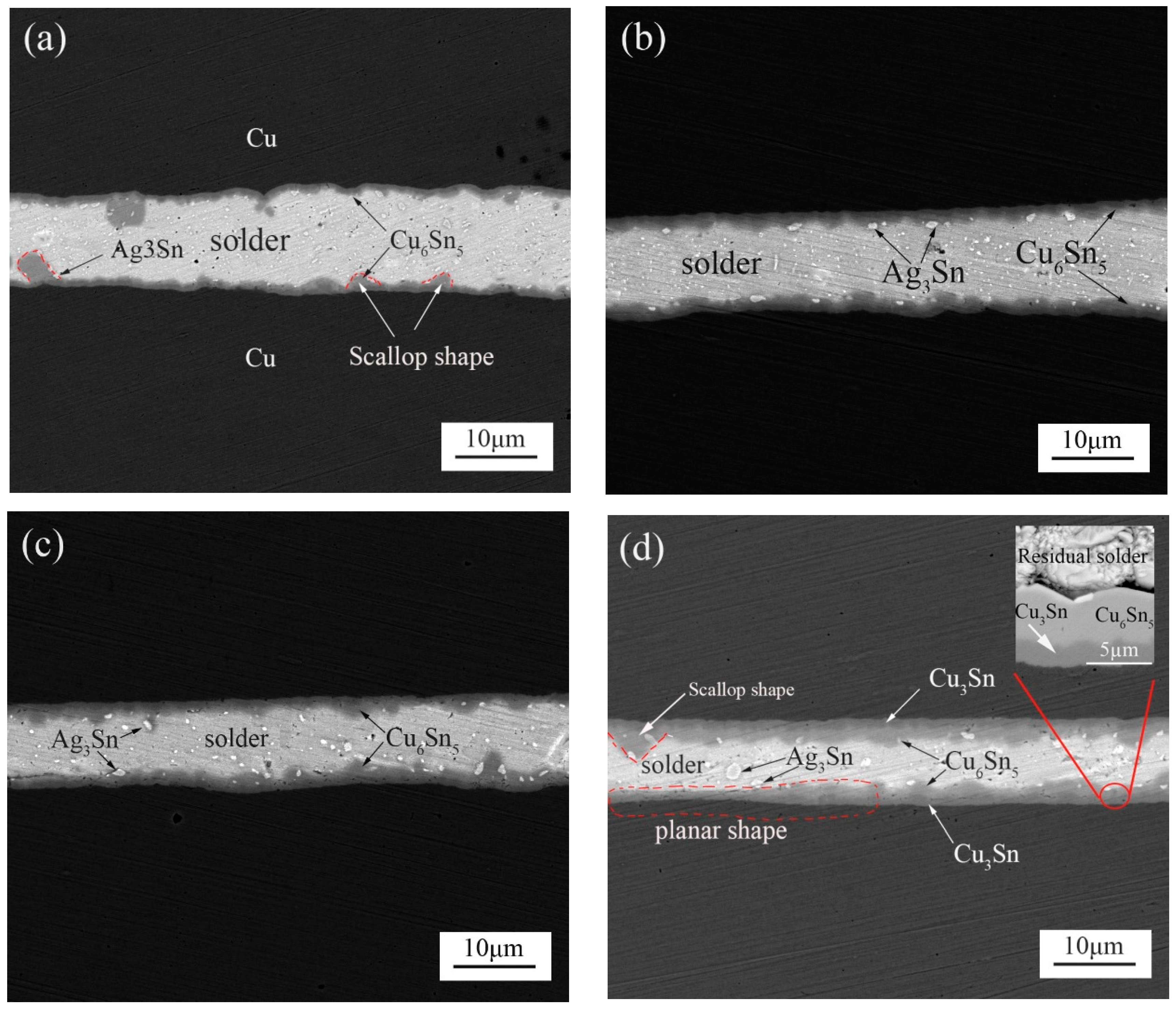
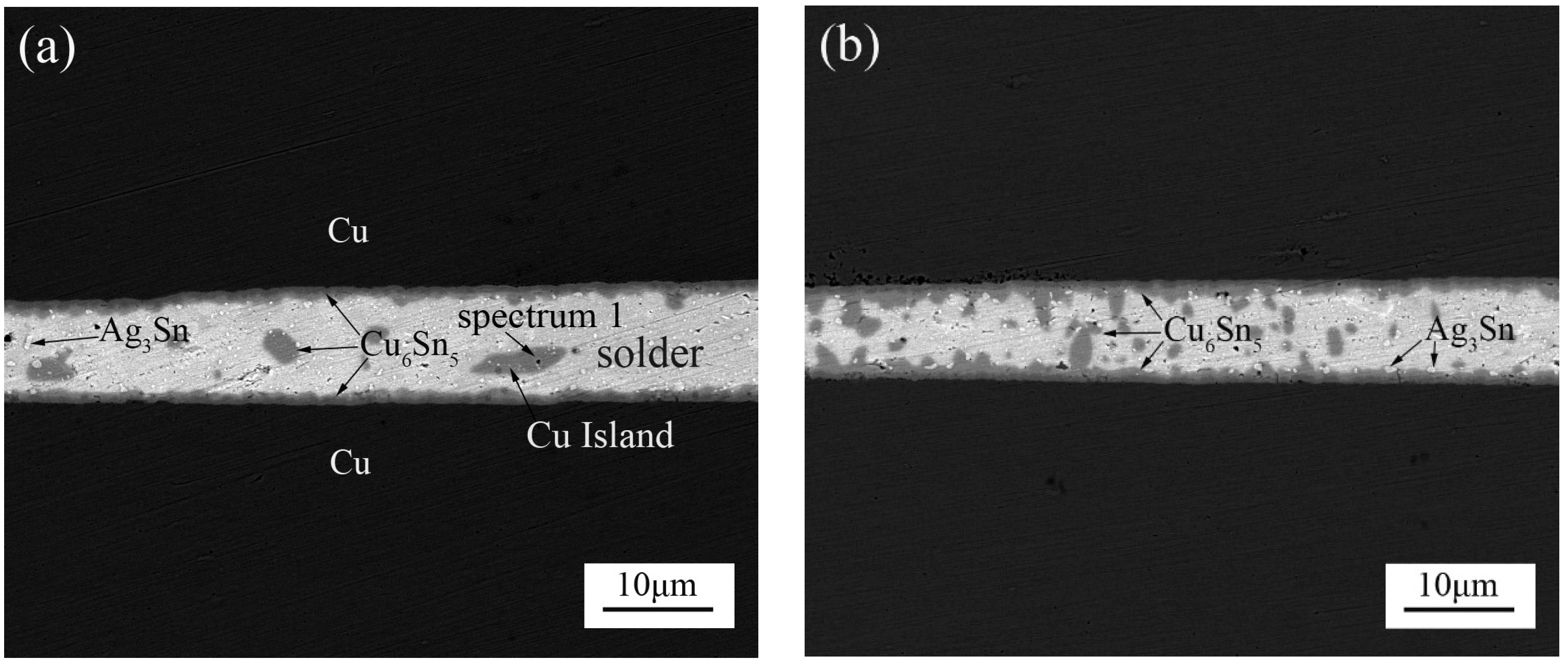


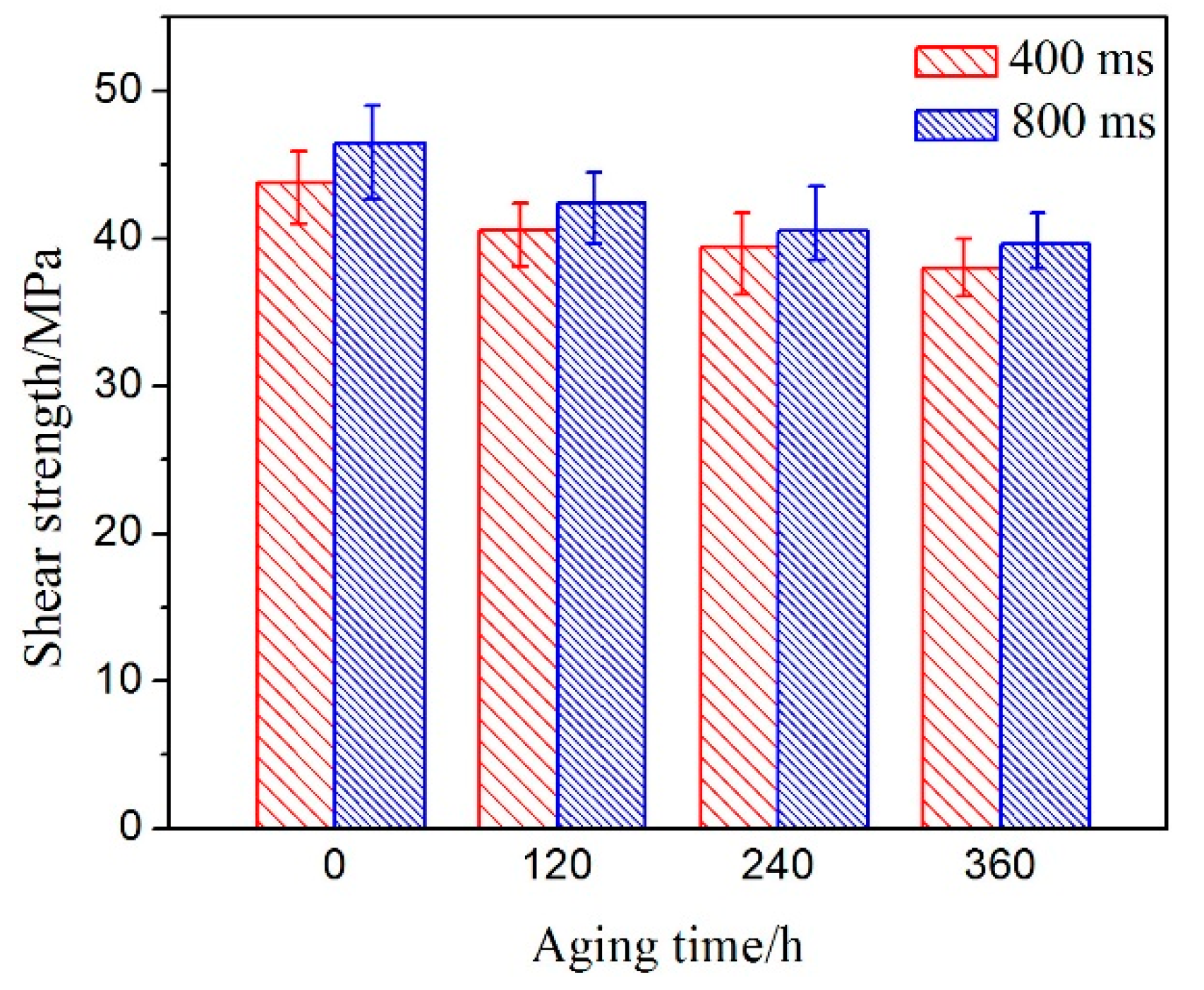
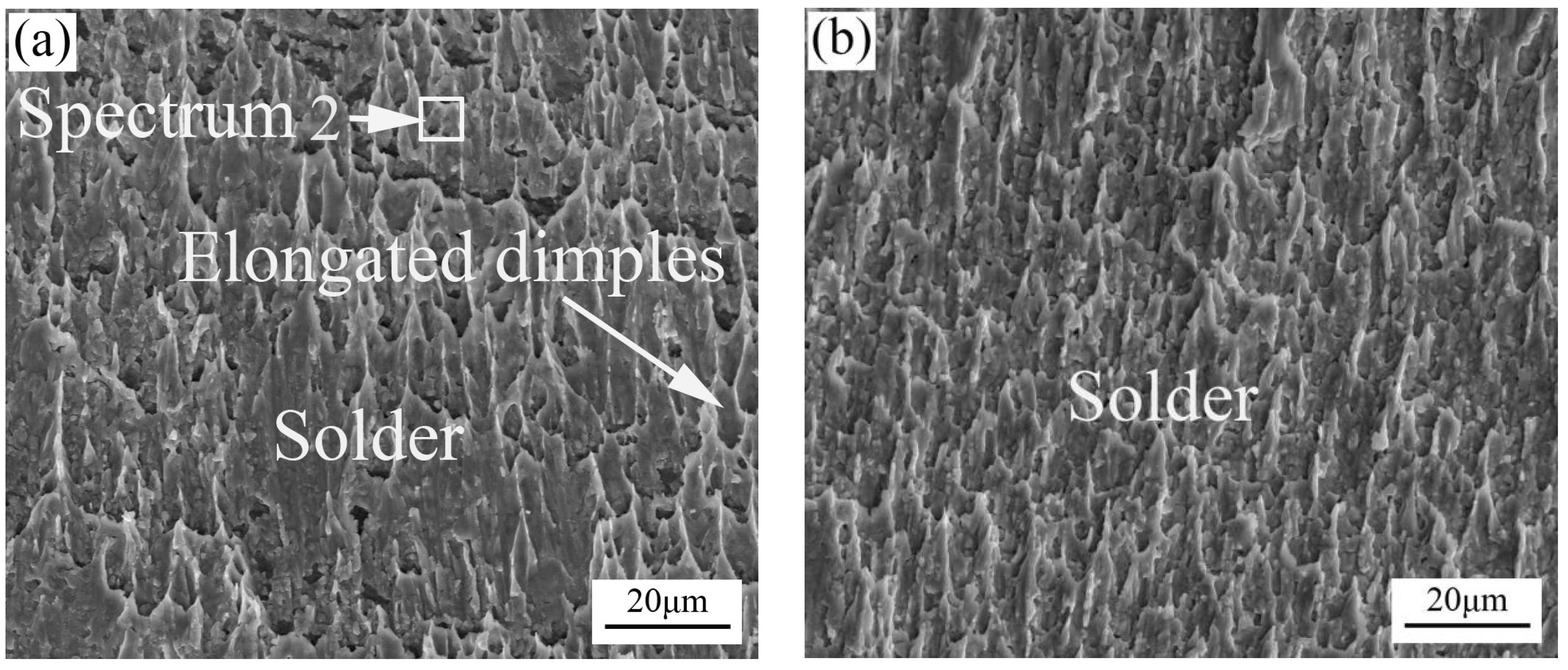
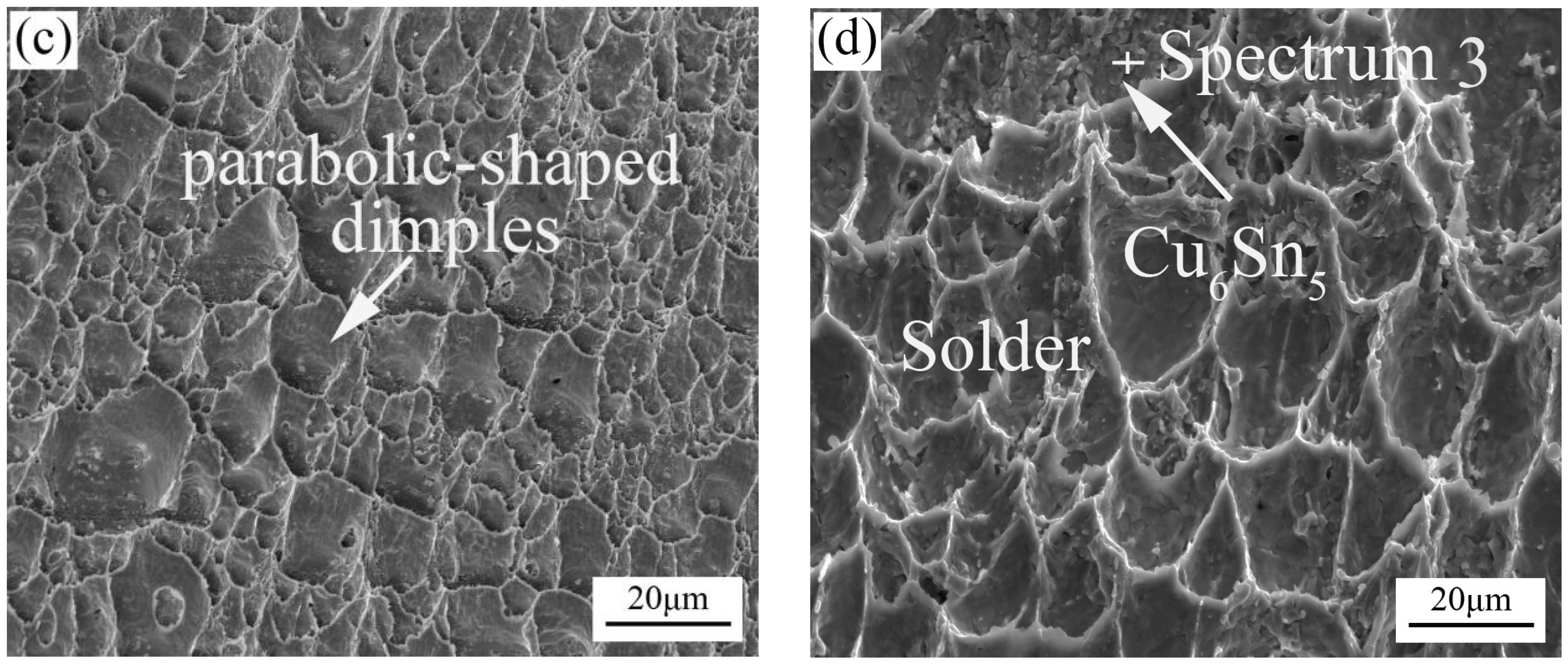
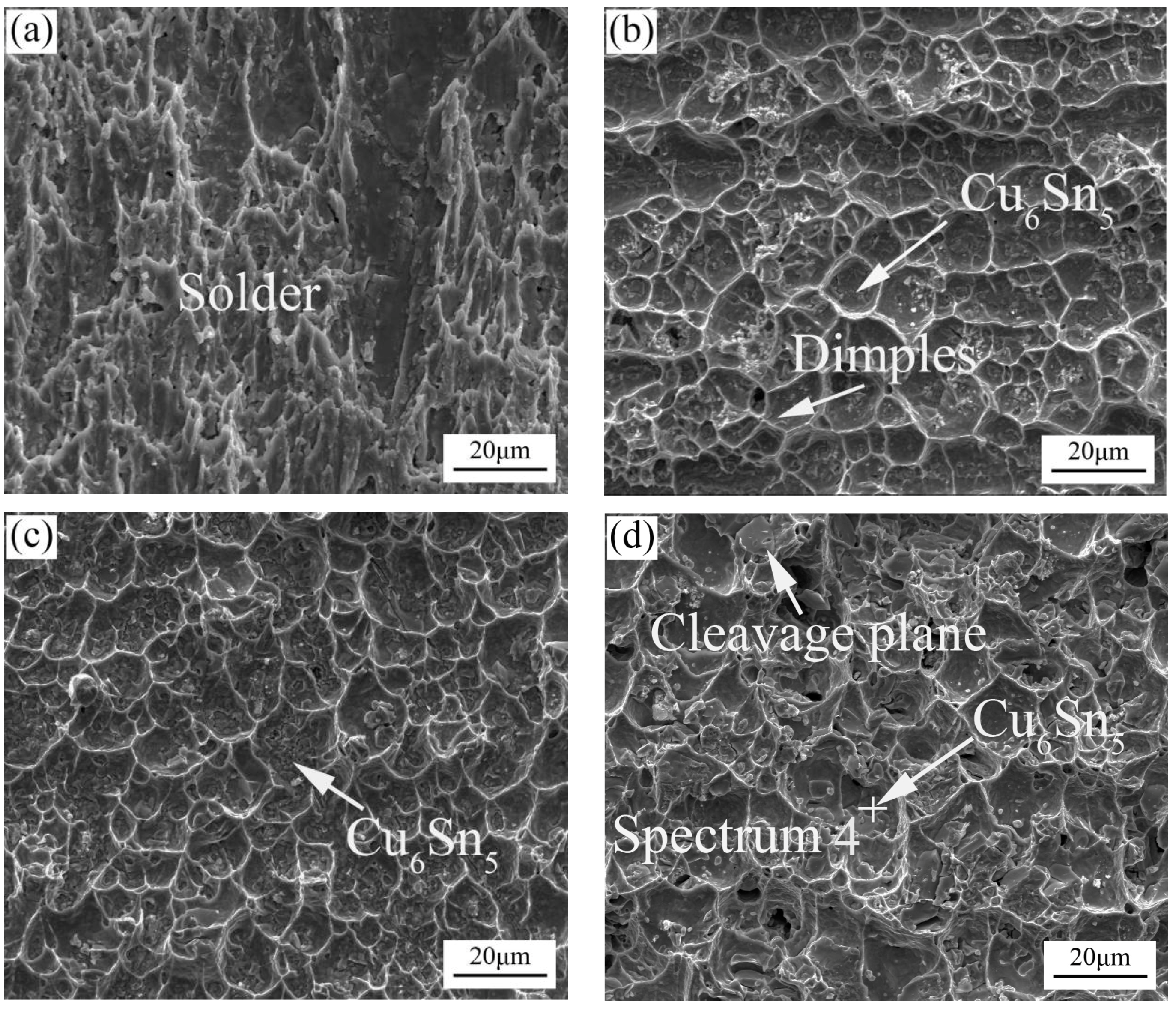
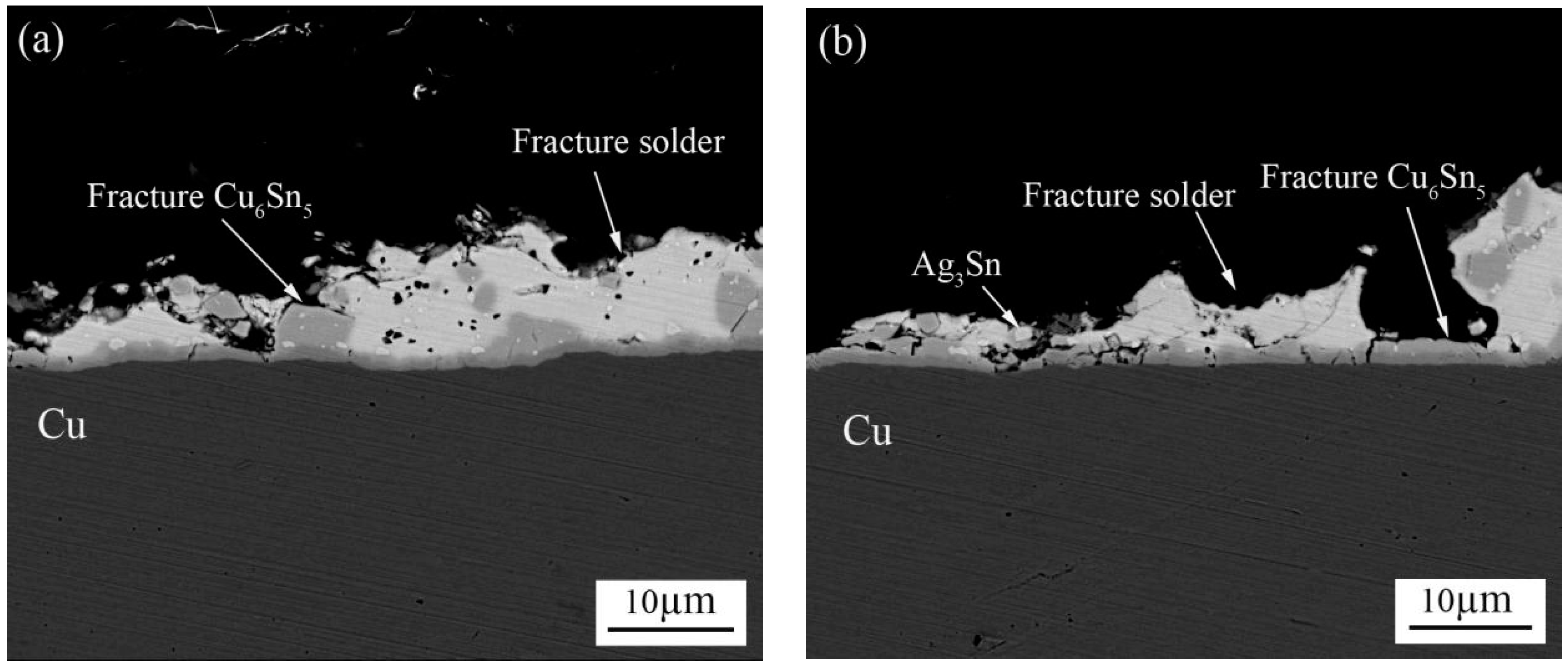
| Sites | Main Elements (at %) | Phase | ||
|---|---|---|---|---|
| Ag | Sn | Cu | ||
| 1 | — | 43.83 | 56.17 | Cu6Sn5 |
| 2 | 4.36 | 94.76 | 0.88 | Sn-3%Ag-0.5%Cu |
| 3 | — | 44.64 | 55.36 | Cu6Sn5 |
| 4 | — | 47.25 | 52.75 | Cu6Sn5 |
© 2018 by the authors. Licensee MDPI, Basel, Switzerland. This article is an open access article distributed under the terms and conditions of the Creative Commons Attribution (CC BY) license (http://creativecommons.org/licenses/by/4.0/).
Share and Cite
Li, Y.; Long, W.; Hu, X.; Fu, Y. Interfacial Reaction and IMC Growth of an Ultrasonically Soldered Cu/SAC305/Cu Structure during Isothermal Aging. Materials 2018, 11, 84. https://doi.org/10.3390/ma11010084
Li Y, Long W, Hu X, Fu Y. Interfacial Reaction and IMC Growth of an Ultrasonically Soldered Cu/SAC305/Cu Structure during Isothermal Aging. Materials. 2018; 11(1):84. https://doi.org/10.3390/ma11010084
Chicago/Turabian StyleLi, Yulong, Weifeng Long, Xiaowu Hu, and Yanshu Fu. 2018. "Interfacial Reaction and IMC Growth of an Ultrasonically Soldered Cu/SAC305/Cu Structure during Isothermal Aging" Materials 11, no. 1: 84. https://doi.org/10.3390/ma11010084





